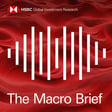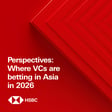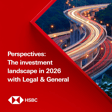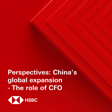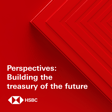Become a Creator today!Start creating today - Share your story with the world!
Start for free
00:00:00
00:00:01

The Macro Brief – Tech supremacy
Sean McLoughlin, Senior Global Industrials Analyst, explains how the boom in AI and cloud computing is fuelling a reacceleration in global capital expenditure.
Disclaimer: https://www.research.hsbc.com/R/101/B6KLVmt
Stay connected and access free to view reports and videos from HSBC Global Investment Research follow us on LinkedIn https://www.linkedin.com/feed/hashtag/hsbcresearch/ or click here: https://www.gbm.hsbc.com/insights/global-research.
Transcript
Introduction to HSBC Global Viewpoint Podcast
00:00:02
Speaker
Welcome to HSBC Global Viewpoint, the podcast series that brings together business leaders and industry experts to explore the latest global insights, trends, and opportunities.
00:00:13
Speaker
Make sure you're subscribed to stay up to date with new episodes. Thanks for listening, and now onto today's show.
00:00:23
Speaker
You're listening to The Macro Brief, the podcast that looks at the issues driving financial markets across the globe. This episode was recorded for publication on the 16th of October, 2025 by HSBC Global Investment Research.
00:00:35
Speaker
All the disclosures and disclaimers associated with it must be viewed on the link attached your media player. And remember to like and subscribe to The Macro Brief wherever you get your podcasts.
Growth of Global Capital Expenditure in Technology Sectors
00:00:49
Speaker
Hello and welcome to The Macrobrief. I'm your host, Piers Butler. Now, global capital expenditure growth has been accelerating this year and is one key sector behind it, technology.
00:01:00
Speaker
Investments in AI and cloud technology are booming. But how much longer can this last? That's what I'm discussing on today's podcast with Sean McLaughlin, Senior Global Industrials Analyst.
00:01:12
Speaker
We'll also be looking at some of the other sectors and regions that are fueling the rebound in CapEx. So, Sean, welcome to the podcast. Thank you. Great to be here. So before we get started, give me just a little bit of background on this report that you publish, the Global CapEx Monitor, which has the tagline, show me the money. So how do you keep track of the money?
00:01:31
Speaker
Indeed. So this is a periodical we publish once or twice a year. And it's a we pool together the consensus forward estimates for over 12,500 of the world's largest listed companies.
00:01:48
Speaker
ah So it's about $4 trillion dollars of global capex, more or less. And we break that down by sector and by region to look at insights into what's hot and what's not in terms of global capital expenditure.
Tech Supremacy and Sector Growth Analysis
00:02:06
Speaker
So what's the latest key takeaways from this ah version of the CapEx Monitor? Yeah, so this report is called the tech supremacy. And surprise, surprise, ah as as you alluded to, at tech is really the runaway growth area. So if we look at the technology sector, um we're looking at year-on-year growth of about 24%. 24%? 24%. And that easily outpaces anything else. The next quickest growing sector is utilities at 11%.
00:02:35
Speaker
Because when I was reading it, I was struck by the the the sheer scale of it. But is that sucking capex from other sectors or is there sheer incremental growth? Well, if we look at absolute dollar numbers, technology, and and we we if you include Amazon in that as well, because Amazon is technically a retailer, so it goes under another category. But if you add Amazon,
00:02:57
Speaker
then technology accounts for roughly one in two incremental dollars being spent in 25. Now, is it sucking growth away?
00:03:08
Speaker
i if If you look at total growth, Growth in 25, it's 7.8%. How does that compare to last year then? it's It's a re-acceleration. So last year, so if if you go back to COVID, ah you had a decline, 4% in 2020. Then you had three consecutive years of bounce back where you had double digit growth.
00:03:29
Speaker
growth, then we saw a fade in 2024 back to 5%. And we're seeing a reacceleration this year up towards 8%. eight percent So you could say that half of that 8% is being taken up by technology.
Historical CapEx Booms and Current Trends
00:03:43
Speaker
And actually, in your report, you highlight how there's been a change in the pecking order of the companies that are spending the most. We have a detailed list of the top individual companies companies spending most capex in 25 in 26 in the report and what you can see is clearly ah change at the top so oil and gas companies were the largest category in those top spenders already up to 2019 and if you look at 2025 well nearly three quarters of capex among the top spenders is being spent by tech companies
00:04:19
Speaker
I just wanted to, again, just in the context of of this great report, yeah in the history of doing this report, what has it been the last 15 years or so? Yes. Have you seen other sectors exhibit that sort of sheer boom in investment?
00:04:32
Speaker
I would say it's hard to to find years in which you had... 50% of concentration. I mean, that that that is quite a remarkable data point. What we have seen over the years, of course, we had a very high telecom spend cycle into the dot-com boom.
00:04:52
Speaker
We had a mining cycle. in the 2000s. We also had a big shipping cycle in the 2000s. We had an oil and gas cycle in 2013 and 2014, where you could see certainly a concentration ah to a certain extent of capex spending in in those years.
00:05:10
Speaker
And yeah I guess at at the moment, it's hard to get a sense of how long this tech boom cycle is likely to last. Well, that's the big question in the market, I i guess. um I mean, what is clear is that the hyperscalers have committed to CapEx spending. And if anything, those CapEx numbers keep rising. And we're seeing, I think, a broadening pool of capital.
00:05:33
Speaker
um we yeah were We're not going to be able to monitor things like private credit in this report. We're looking at listed equity capital spending. But it's clear that um There is no shortage today of capital going into a So let's get a bit more granular and look at individual sector trends.
Influence of Oil Prices on CapEx Decisions
00:05:52
Speaker
Oil and gas is obviously seeing growth, but how how big a factor historically has the oil price been? I guess I'm asking the question, bearing in mind that sometimes it takes years to develop an oil field. So oil companies having to take a long-term view irrespective of the cycle?
00:06:10
Speaker
Yes, I think oil and gas spending is oil price dependent. um For instance, we look at shale in the US, s which has a $60 oil price as a you know barrier, if you like. So if oil price falls sub 60, then there's a threat to certainly to new shale investment.
00:06:29
Speaker
And I think, yes, in a very high oil price environment, that has tended to favor ah let's say, some of the riskier investments, maybe new subsea, and a a low oil price tends to defer some of that. So that there is there is a broad correlation. And at the current level, what what are we seeing? Well, we're we're looking at the moment at low growth in oil and gas next year at the current oil price.
00:06:59
Speaker
What about chemicals? I mean, that, that according to report, has been in a doldrum since 2022. Any signs of bottoming out there? I would say no. If anything, it's one of the sectors that has, I think, some of the clearest numbers. So we're looking at a 6% decline in capex expectations in 2025 and another 5% decline in 2026. So it's a sector that I think is very visibly um not seeing any kind of recovery.
00:07:27
Speaker
Still very much in the doldrums. And transport, I guess one of the big components in transport is shipping, but are there any other factors? Yes, we we are ah probably at the tail end of ah of a pretty meaningful cycle on on the commercial side of of shipping.
00:07:41
Speaker
Which was kind of COVID-related, wasn't it? Which was which was definitely COVID-related. And we are certainly still in an LNG upcycle. So the again, a lot of moving parts in in the maritime industry, but um it looks as though um we're seeing minor capex growth.
00:08:02
Speaker
Airlines is still showing good upcycle. Everybody wants to travel, don't they? And road haulage is less exciting. You mentioned utilities as well at the start of the conversation. Is utilities being impacted by technology in in the sense that that's driving a significant demand for electricity?
Investment in Utilities and Renewable Energy
00:08:22
Speaker
Well, the way that we break down the utility segment, roughly three quarters is electrical utilities. So we see this broadly as a sign of the push on electrification. in other words, it's the need to invest in renewables.
00:08:38
Speaker
It's also a need to invest in grids to integrate renewables. And now, obviously, you have the AI data center power consumption kicker that, again, is also driving a lot of utility investment.
00:08:50
Speaker
Is there likely to be some capacity constraint in a sense that this boom in AI and the demand for electricity has been... <unk>s taken us all by surprise in a way, and it takes a while to build power stations. and I mean, we've seen examples of some of these AI companies trying to secure our dedicated sources of electricity supply, nuclear power stations and what have you. Is that is there going to be a bit of a bottleneck in that respect?
00:09:15
Speaker
I think as the CapEx numbers increase and the speed of that CapEx increases, remains high, then yes, I think there's an increasing risk of physical bottlenecks, be it the availability of power equipment, be it grid connections, and be it other areas of of of equipment. And I think the market is is kind of chasing some of these bottlenecks.
00:09:40
Speaker
In your report, you say that there could be upside potential your CapEx forecasts. ah Remind us what you're going for broadly. And is that really because you think this tech supremacy is only just getting going?
00:09:54
Speaker
To an extent, yes. twenty twenty six 2026, the initial view is that we're only looking at 1.6% global growth. Even to me, that seems a little bit on the low side.
Regional Trends in CapEx Growth and Declines
00:10:03
Speaker
That is already concentrated really in one sector, and that is technology, up 9.5%. We're seeing declines in construction, in process.
00:10:13
Speaker
We're seeing declines in EMEA and in Asia Pacific. So it's concentrated in tech and it's concentrated in the Americas. You mentioned a couple of regional differences. ah ah any other big regional messages coming out of the survey?
00:10:26
Speaker
The other clear message, I guess, is on China. So China continues to be in a capex negative moment, negative this year, continuing negative next year. And again, a big component of that is the construction sector unwind.
00:10:41
Speaker
So this is the legacy of having, there were obviously some years ah I bet in into your report, which i mean it was kind of leading the way, but but but it's a sort of legacy of having had so much investment in the construction now, you know, property cycle sort of slowing down, that is having an impact in the overall statistics.
00:10:58
Speaker
Yes. Again, the aftermath of another cycle. So, Sean, you go and talk to companies in terms of writing your all reports and what have you. I mean, do you sense that there's a sense of optimism associated with with with CapEx or are they still cautious because it has been difficult past few years?
00:11:16
Speaker
I'd say it's a mixed picture. There's clearly optimism around anything that is AI related and that spreads across a fair few sectors. Now, certainly we had a lot of optimism earlier this year in Germany that that was dragging, I think, you know that a lot of you know positive views on on Europe. That looks to be, I think, maybe less positive now. Is that because you know when you talk about CapEx, it's one thing to have the intention, but to actually put it into reality is is a lot harder?
00:11:50
Speaker
Yes. And ultimately, I think going from you know policy ambition to actual dollars spent in the ground is um that there is a lag. we We see this, for example, in the US data. you know We've seen a lot of the Biden era policies were introduced in 21, 22, and we really saw in 23 and 24 construction dollars coming significantly up.
00:12:15
Speaker
That has been a fascinating insight into the CapEx cycle. Show me the money, as they say. ah We'll have you back to see what actually turned out. Sean, thank you very much. Thank you, Piers.
00:12:28
Speaker
A couple of key reports from the Global Investment Research Team to bring to your attention now. In the October edition of the Currency Outlook, Paul Mackle and team look at the prospects for the US dollar.
00:12:40
Speaker
And in the latest HSBC Global Macro Strategist, Meridogun brings together the top themes and our best ideas across key asset classes and geographies. This month, the focus is on the U.S. growth outlook, global fiscal vulnerabilities, and the ascendancy of emerging markets.
00:12:56
Speaker
For more information on those reports or for any other questions, please email us at askresearch at hsbc.com.
Conclusion and Listener Engagement
00:13:03
Speaker
And don't forget to like and subscribe to The Macro Brief wherever you get your podcasts.
00:13:08
Speaker
And please also check out our sister podcast, Under the Banyan Tree, where hosts Fred Newman and Harold van der Linde put Asian markets and economics into context.
00:13:20
Speaker
So that's it from us this week. From all of us here, thanks for listening, and please join us again next week on The Macrobrief.
00:13:49
Speaker
Thank you for joining us at HSBC Global Viewpoint. We hope you enjoyed the discussion. Make sure you're subscribed to stay up to date with new episodes.

